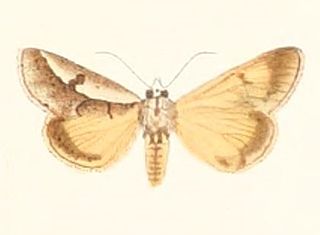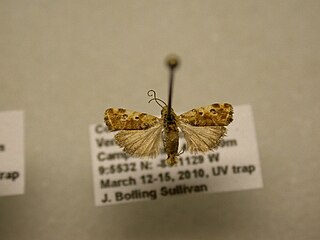Catabenoides is a genus of moths of the family Noctuidae.

Spragueia apicalis, the yellow spragueia, is a moth of the family Noctuidae. The species was first described by Gottlieb August Wilhelm Herrich-Schäffer in 1868. It is also found in North America, Central America, Cuba and Peru.

Orodesma apicina is a species of moth in the family Erebidae first described by Gottlieb August Wilhelm Herrich-Schäffer in 1868. The species is found in Florida, Central America and Cuba. It is sometimes recorded in Great Britain through accidental importation in produce.

Elaphria agrotina is a moth of the family Noctuidae first described by Achille Guenée in 1852. It is found from North America, through Central America, the Antilles and Cuba to Brazil and Argentina.
Correbidia terminalis is a moth in the subfamily Arctiinae. It was described by Francis Walker in 1856. It is found from Mexico through Central America and Cuba and Puerto Rico to South America.

Baniana relapsa is a species of moth of the family Erebidae. It is found on the Antilles.
Eutelia furcata, the Florida eutelia moth, is a moth of the family Noctuidae. The species was first described by Francis Walker in 1865. It is found from the southern United States to Mexico, Cuba, Puerto Rico and Central America.
Coenipeta medina is a species of moth in the family Erebidae first described by Achille Guenée in 1852. The species is found from Texas through Central America and Cuba to Brazil.

Caenurgia chloropha, the vetch looper moth, is a moth of the family Erebidae. The species was first described by Jacob Hübner in 1818. It is found in the south-eastern United States, northern Mexico and Cuba. Strays may be found as far north as southern Ontario.
Argidia subvelata is a moth of the family Noctuidae first described by Francis Walker in 1865. It is found in Mexico, Costa Rica, Puerto Rico, Cuba and Brazil.

Euscirrhopterus poeyi, the pullback moth, is a moth of the family Noctuidae. The species was first described by Augustus Radcliffe Grote in 1866. It is found from southern Florida and Mexico, through Central America to Brazil. It is also found in the Caribbean, including Cuba.

Spragueia perstructana is a moth of the family Noctuidae first described by Francis Walker in 1865. It is found from the United States, south to the Caribbean and Central America, including Costa Rica.
Leucania inconspicua is a moth of the family Noctuidae first described by Gottlieb August Wilhelm Herrich-Schäffer in 1868. It is found in Florida, Cuba, Puerto Rico, Jamaica, the Lesser Antilles and from Mexico to Brazil.
Melipotis famelica is a species of moth in the family Erebidae first described by Achille Guenée in 1852. The species is found from the southern United States to the Caribbean and Paraguay.
Cobubatha metaspilaris is a moth of the family Noctuidae, described by Francis Walker in 1863. It is found in the southern United States, British Virgin Islands and Cuba.
Lacinipolia parvula is a moth of the family Noctuidae first described by Gottlieb August Wilhelm Herrich-Schäffer in 1868. It is found in Florida and on Cuba and Puerto Rico.

Melipotis acontioides, the royal poinciana moth, is a species of moth in the family Erebidae. It was first described by Achille Guenée in 1852. The species is found from the southern United States through Mexico and Central America to Brazil, Argentina and the Galápagos Islands. It is also found in the Caribbean, including Cuba and the British Virgin Islands, Jamaica and Puerto Rico.
Speocropia trichroma is a moth of the family Noctuidae first described by Gottlieb August Wilhelm Herrich-Schäffer in 1868. It is found in Florida and on Cuba.

Spodoptera pulchella, the Caribbean armyworm moth, is a moth of the family Noctuidae found in Florida and Texas, Central America, the Greater Antilles, and the Bahamas. It was first described by Gottlieb August Wilhelm Herrich-Schäffer in 1868.

Condica punctifera is a moth of the family Noctuidae first described by Francis Walker in 1857. It is found in southern Florida and on the Bahamas, Cuba, Jamaica, Hispaniola and Puerto Rico.








